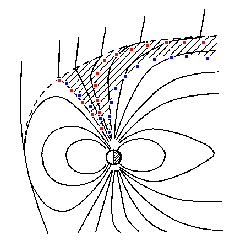 Magnetospheric boundary layer
Magnetospheric boundary layer
spaceweb@oulu.fi - last update: 5 January 1999, 1625 UT (RR)
 Magnetospheric boundary layer is a region
close to the magnetopause in which
magnetosheath plasma has
strong influence. It can be divided into four parts:
Magnetospheric boundary layer is a region
close to the magnetopause in which
magnetosheath plasma has
strong influence. It can be divided into four parts:
- Plasma mantle
- Entry layer
- Exterior cusp
- Low-latitude boundary layer, LLBL ("cleft" at low altitudes)
However, some researchers don't define the entry layer at all as a separate region. A new boundary called the free-flow boundary has been
suggested to exists between the exterior cusp and the magnetosheath
(this is the boundary that is often plotted as a dashed line in schematic
figures of the magnetosphere).
Boundary layer is a very special region, not only because of the presence of
magnetosheath plasma, but also because of the still uncertain topology.
Also the mapping of the boundary layer regions to low altitude is not
quite certain yet, although it is clear that these spatially vast regions map
into a very limited region around the low altitude cusps.
The mapping can be studied either by using advanced magnetic field models,
or by low-altitude measurements of
- charged-particle precipitation
- visible auroral emissions
- geomagnetic pulsations
- correlation between optical emissions and geomagnetic pulsations
- field-aligned currents
- VLF signal characteristics and ionospheric absorption of cosmic noise
- incoherent scatter radar observations
- coherent HF radar backscatter
Charged-particle precipitation characteristics seem to be the best (low-altitude)
means to categorize the boundary layers. Daytime auroral
precipitation from these regions is responsible for the daytime zone of soft
precipitation, or the cusp/cleft precipitation.
The recent loss of Cluster satellites was a bad blow to the in situ study of the
Earth's boundary regions.
Plasma mantle
The plasma mantle was first defined by Rosenbauer et al. (1975). It
- covers much of the high-latitude magnetosphere, extending poleward of the cusp region
- de-energized magnetosheath plasma
- densities: few times 0.01 - 1 cm^-3
- temperatures: about 100 eV
- tailward flow velocities: 100-200 km/s
- region of the so-called mantle current and discrete auroras
- the density and energy often decrease when moving inward from the magnetosheath
towards the magnetosphere (velocity filter effect, see the figure below);
at low-altitude this creates an energy-latitude dispersion
- generally thicker for southward than northward IMF Bz
 Formation of the plasma mantle. Low-energy ions (blue) take longer to mirror
from the ionosphere than do higher energy ions (red), and are thus
convected
further across field lines, giving decreasing energy and density with
deeper penetration into the mantle (towards the magnetosphere).
Formation of the plasma mantle. Low-energy ions (blue) take longer to mirror
from the ionosphere than do higher energy ions (red), and are thus
convected
further across field lines, giving decreasing energy and density with
deeper penetration into the mantle (towards the magnetosphere).
Entry layer
The entry layer was first defined by Haerendel and Paschmann (1975) and Paschmann
et al. (1976). It
- connected to the equatorward edge of the cusp region
- plasma density almost as high as in the magnetosheath
- generally lacking antisunward flow
- BUT: does it really exists?
- region of hot stagnant magnetosheath plasma at the high altitude cusp
References
- Haerendel, G., and G. Paschmann, Entry of solar wind plasma into the
magnetosphere, in Physics of the Hot Plasma in the Magnetosphere,
ed. B. Hultqvist and L. Stenflo, p. 23, Plenum, New York, 1975.
- Paschmann, G., G. Haerendel, N. Sckopke, H. Rosenbauer, and P. C. Hedgecock,
Plasma and magnetic field characteristics of the distant polar cusp near local
noon: The entry layer, J. Geophys. Res., 81, 2883-, 1976.
- Rosenbauer, H., H. Grunmwaldt, M. D. Montgomery, G. Paschmann, and
N. Sckopke, Heos 2 plasma observations in the distant polar magnetosphere:
The plasma mantle, J. Geophys. Res., 80, 2723-, 1975.
See also:
 Magnetospheric boundary layer
Magnetospheric boundary layer Magnetospheric boundary layer
Magnetospheric boundary layer Magnetospheric boundary layer is a region
close to the magnetopause in which
magnetosheath plasma has
strong influence. It can be divided into four parts:
Magnetospheric boundary layer is a region
close to the magnetopause in which
magnetosheath plasma has
strong influence. It can be divided into four parts:
 Formation of the plasma mantle. Low-energy ions (blue) take longer to mirror
from the ionosphere than do higher energy ions (red), and are thus
convected
further across field lines, giving decreasing energy and density with
deeper penetration into the mantle (towards the magnetosphere).
Formation of the plasma mantle. Low-energy ions (blue) take longer to mirror
from the ionosphere than do higher energy ions (red), and are thus
convected
further across field lines, giving decreasing energy and density with
deeper penetration into the mantle (towards the magnetosphere).